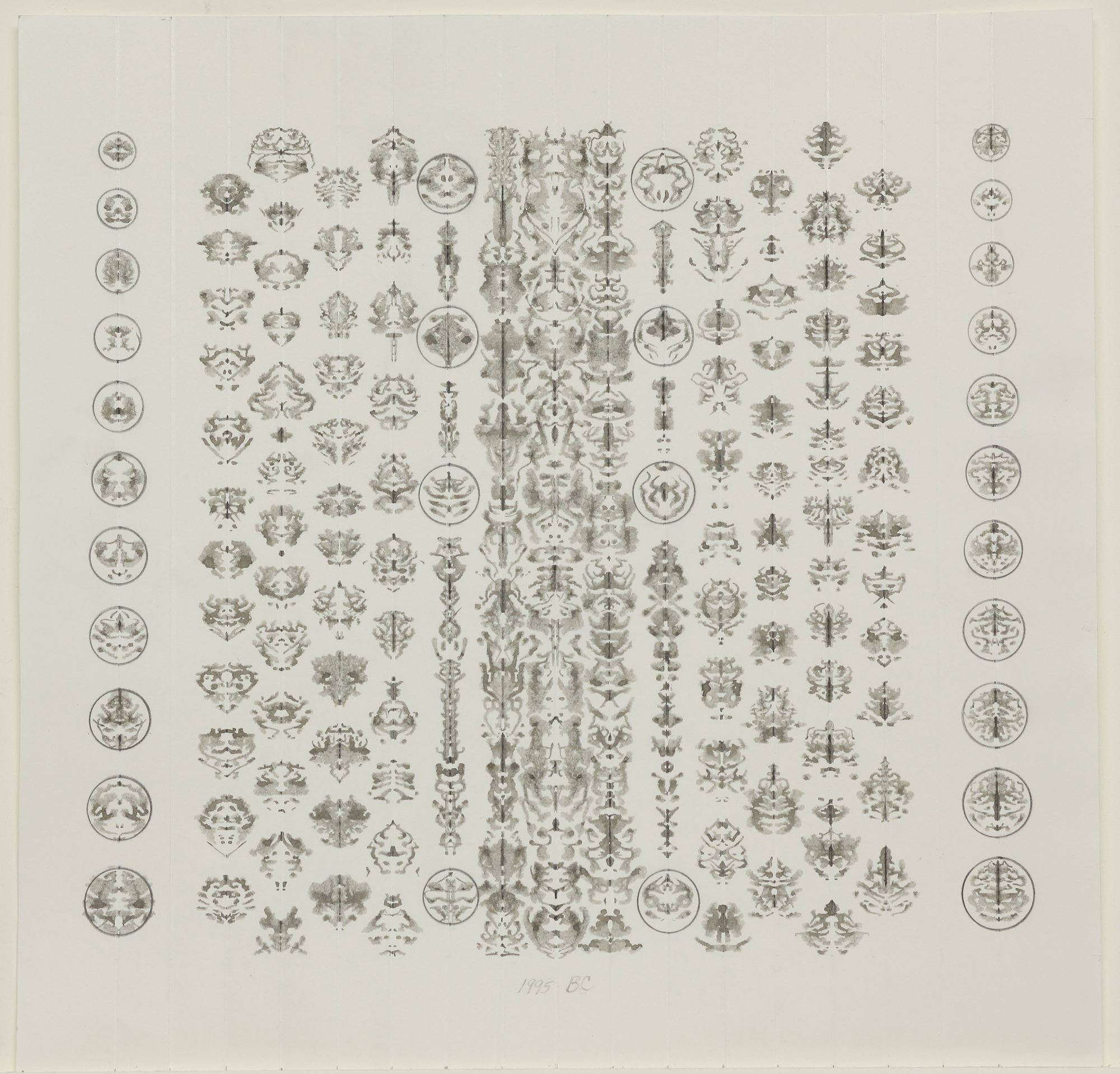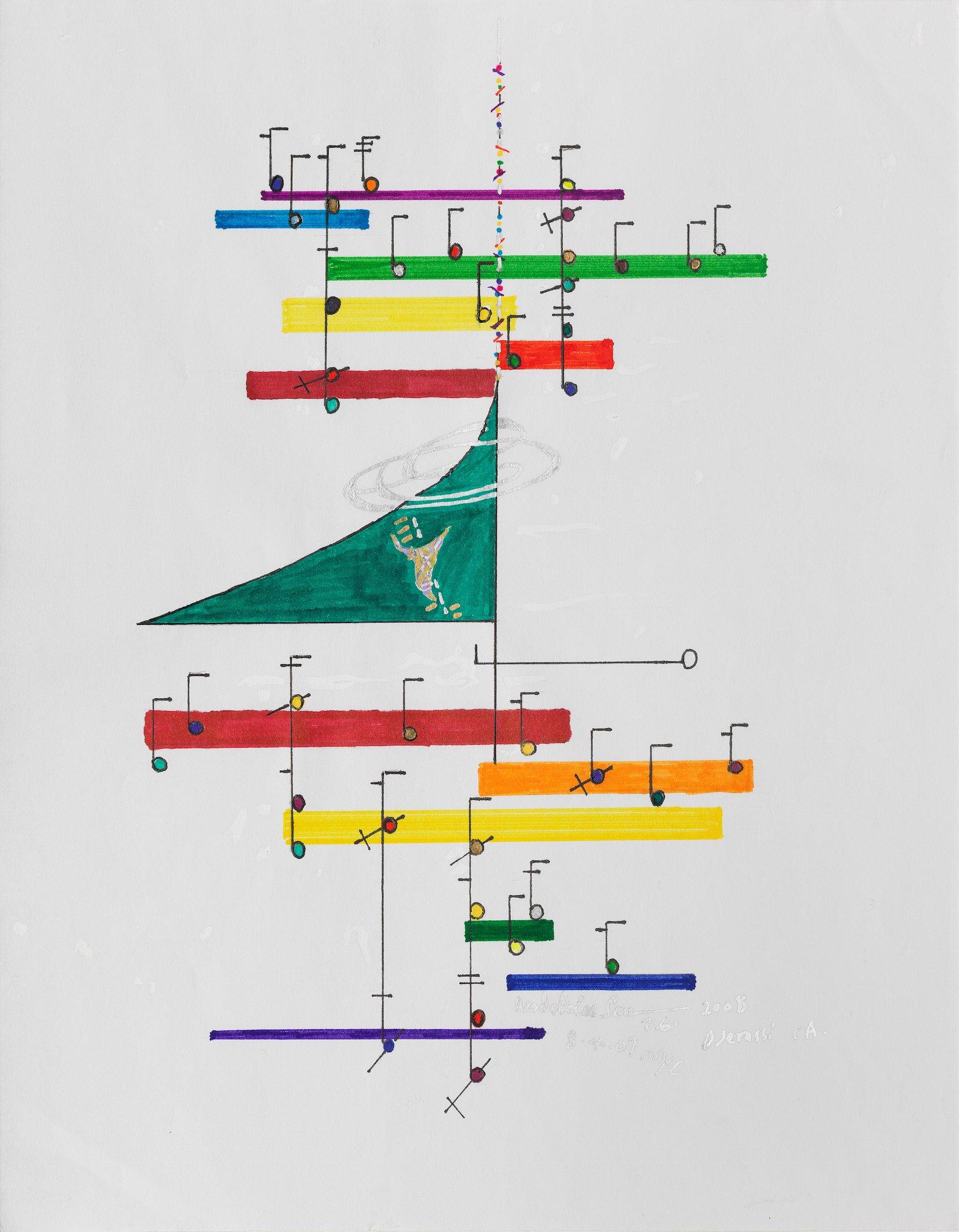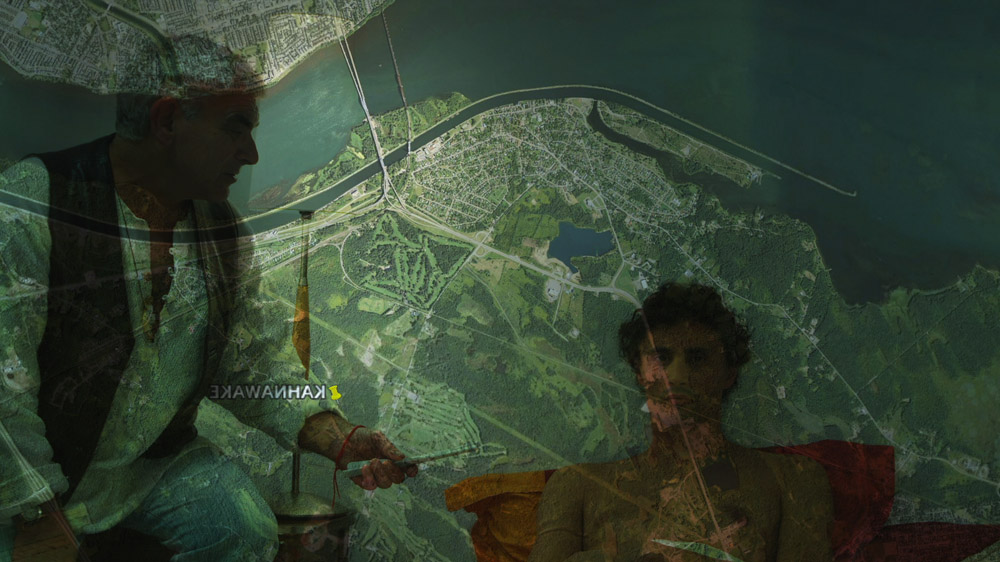
© » KADIST
Marina Rosenfeld
The installation Music Stands: Free Exercise 7, 8, and 9 by Marina Rosenfeld consists of music stand-like structures and a corresponding set of panels and acoustic devices that direct, focus, obstruct, reflect and project sound in the gallery. Together the components play on the connection between aural and social relations signified by the music stands. An episodic score emanates from the work’s sound system, momentarily interrupting the atmosphere with brief eruptions of electronic sounds and vocality.

© » KADIST
Arash Fayez
The short film I Can Only Dance to One Song by Arash Fayez features a series of people from the migrant community in Barcelona singing along or dancing to songs of their choosing. The video begins with a man contently sings along to a song while getting his hair cut at the barber shop; a woman dances emotively to another song in an empty room full of desks, maybe a school or place of religious study; in a food market, a cashier nods his head to music while tallying customers’ orders and then later moves through the aisles of his store passionately dancing and mouthing the lyrics as if he were in a music video. Expanding on the music video aesthetic, the film then cuts to a group of young men perched in front of a graffitied wall, cheerfully dancing and rapping along with the song playing from their stereo.

© » KADIST
Naama Tsabar
Naama Tsabar’s sculptural works are developed serially. The series Work on Felt references the history of post-minimal sculpture: from Robert Morris to Joseph Beuys’s social sculptures. However one can equally relate her work to 1970s conceptual performers such as Terry Fox or Paul Kos.

© » KADIST
Andrew Norman Wilson
On the first day of the Covid-19 lockdown in New York, Andrew Norman Wilson was evicted from his sublet and decided to board a $30 flight to Los Angeles that evening. From a cottage that faces the Hollywood sign, he began to dwell on an encounter he had with a woman driving alongside him on the highway, emphatically singing along to the song he was listening to through the same radio station. That song was Phil Collins’s “In the Air Tonight.” For Wilson, the uncanny synchronicity of this encounter with a stranger tuned into the same frequency resonated with the inspiration for Phil’s song, which he first heard as a teenager while getting high in a friend’s basement.

© » KADIST
Diamond Stingily
Dad is Byron is an audio work produced in collaboration between Diamond Stingily and her father, the house musician Byron Stingily. Viewers are invited to pick up a wall-mounted telephone that has been retrofitted to play a recording of a conversation between Stingily and her father. Although initially the artist planned to focus on her father’s recollections of the violence during his childhood in Chicago in the 1960s and how music helped him cope, the conversation has a natural and intimate meandering.

© » KADIST
Shimabuku
For the two-channel work Asking the Repentistas – Peneira & Sonhador – to remix my octopus works Shimabuku asked two Brazilian street singers to compose a ballad about his previous works with octopi (in which he created traditional Japanese ceramic vessels to catch octopi, with a fisherman who took him on his boat to test them out as we can see on one of the channel). In the Brazilian singers’ ballad, Shimabuku is transformed into a fisherman, the greatest fisherman in Japan, but a kindly fisherman who returns his catch to the sea. The artwork thus becomes facilitator for an interaction between different cultures and interpretations.

© » KADIST
Jay Chung and Takeki Maeda
Jay Chung and Q Takeki Maeda remake a clip from the 1970s they found on the internet, and without really changing this archive material, displace it by imitating the staging and the acting with scrupulous precision. The slightest details are reproduced identically with great minutiae. The facial expressions are absurd, the prim attitude makes no sense.

© » KADIST
Sung Hwan Kim
An early work in Sung Hwang Kim’s career, the video Summer Days in Keijo—written in 1937 is a fictional documentary, the film is based on a non-fiction travelogue, In Korean Wilds and Villages , written by Swedish zoologist Sten Bergman, who lived in Korea from 1935 to 1937. In Kim’s film, a Dutch female protagonist traces Bergman’s path in the present-day Seoul (Keijo was the Japanese name for Gyeongseong, currently Seoul). The protagonist navigates through spaces that have been rebuilt since the 1950s onwards, and the scenes are narrated by a voice-over based on Bergman’s written description of the modern city in 1937.

© » KADIST
Yuyan Wang
One Thousand and One Attempts to Be an Ocean by Yuyan Wang reflects on the experience of not being able to see the world with depth perception. Made up of micro-events from ‘satisfying videos’ that swarm on the internet, the abstract narrative unfolds through layers of appropriation; referencing trance and minimal music in the process. The work addresses a desire for groundless waves, blended with today’s inexorable entropy of information societies.

© » KADIST
Lenka Clayton and Phillip Andrew Lewis
Five Hundred Twenty-Four, a single-channel video installation by Lenka Clayton and Phillip Andrew Lewis, features singers from over twenty Cleveland-area choirs counting numbers in an iterative process: one person sings “one”, then two people sing “two”, and so forth, to 524. Each choir was filmed separately, and the artists weave together the audio while the video features each choir individually. The juxtaposition of different contexts in which singing occurs functions as an embedded sociological study of various communities throughout the region.

© » KADIST
Javid Soriano
Set in the infamous Tenderloin district of San Francisco, Factotum of the City is a documentary film by Javid Soriano that delves into the life of a former world-class opera singer turned self-styled street hustler. Factotum of the City centers around Tim, a Juilliard School graduate who fell from the world opera stage into the bowels of San Francisco’s Tenderloin, an destitute place located amidst the city’s vibrant downtown. The film follows the opera man as he navigates the Tenderloin and its surrounding locales, allowing a glimpse into some of the bizarre, tragic, and comical situations he endures while living as a self-fashioned ‘Figaro’ of the street.

© » KADIST
Bárbara Wagner & Benjamin de Burca
Originally commissioned for the 32nd Sao Paulo Biennial, the film Estás vendo coisas (You are seeing things) depicts the subculture of Brega music, a fusion of American Hip Hop, Brazilian techno and Caribbean reggaeton that emerged in North Eastern Brazil over the last decade. Part anthropological documentary and part musical the film speaks about the realities of Brazil with its enormous social and economic tensions.

© » KADIST
Mona Benyamin
A moonscape is a vista of the lunar landscape or a visual representation of this, such as in a painting. The term “moonscape” is also sometimes used metaphorically for an area devastated by war. Moonscape by Mona Benyamin is inspired by and dedicated to the Lunar Embassy—a company that now sells land on a variety of planets and moons, established in 1980 by a man called Dennis M. Hope, who claimed ownership of the Moon.
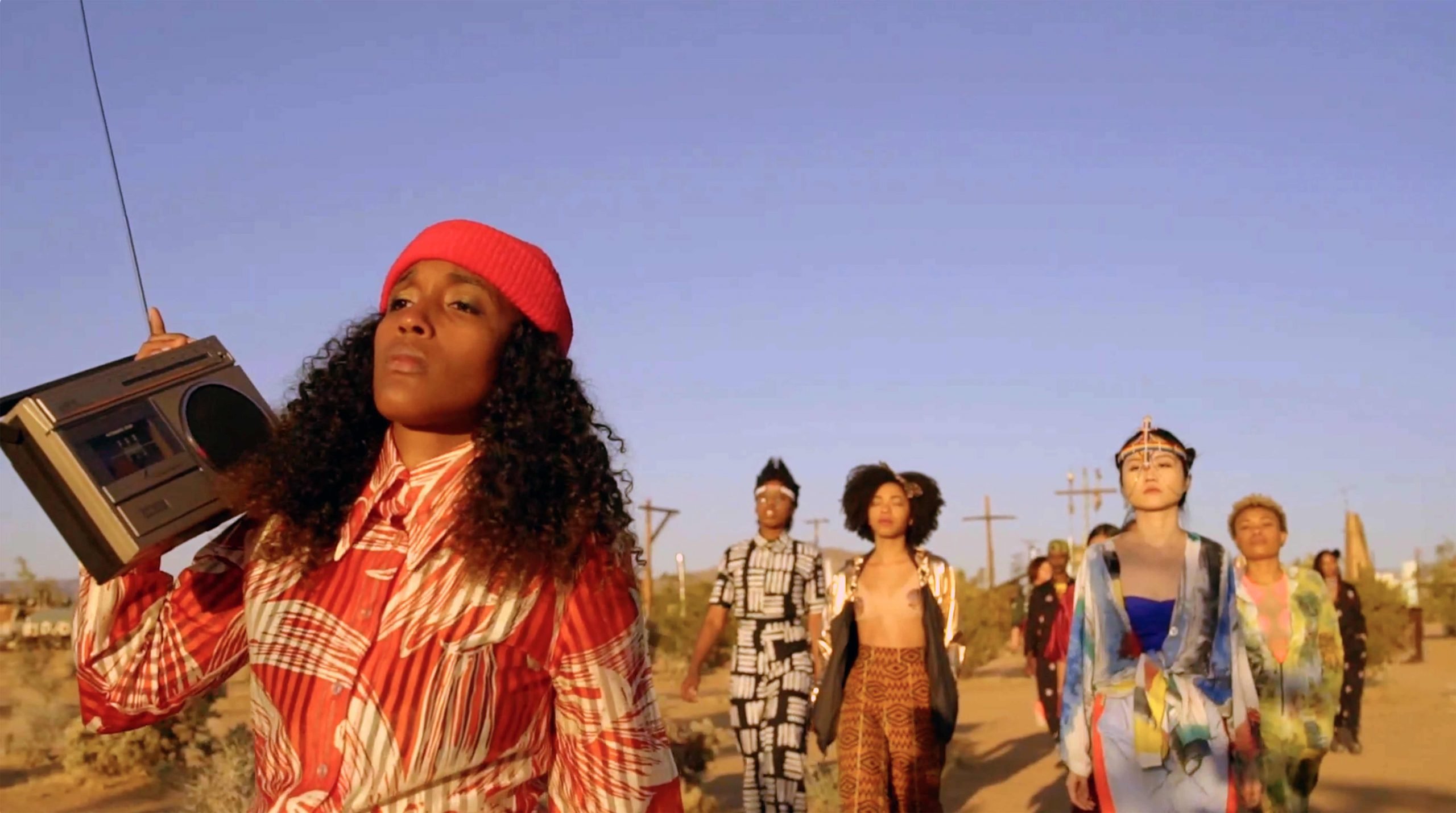
© » KADIST
Cauleen Smith
Set to the iconic and spiritual music of Alice Coltrane’s Turiyasangitananda (1937–2007), Cauleen Smith’s film Sojourner travels across the US to visit a series of sites important to an alternative and creative narrative of black history. While the approach may appear spiritual, it is more futuristic (Afrofuturism and Radical Jazz) than religious. Smith is interested in using the individual stories of “those who have formed their own solutions” as a reconstructive and healing lens for considering the past.

© » KADIST
Wu Tsang
Poet and writer Fred Moten gesticulates joyously during Girl Talk by artist Wu Tsang. Moten is dressed in light drag—a studded cloak hanging loosely over his body, his eyes and mouth adorned with makeup. Filmed in a sunlit garden, Moten whirls in slow motion to the trickle of a lion-headed water fixture and the acapella rendition of jazz standard Girl Talk by singer Josiah Wise.
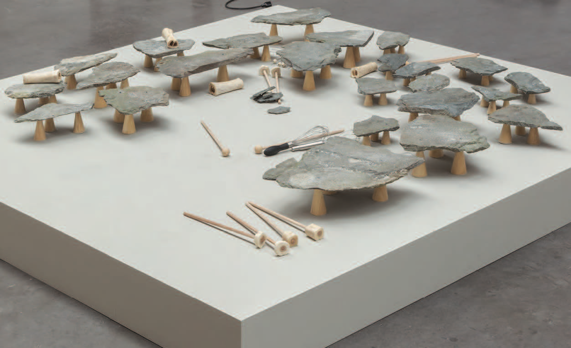
© » KADIST
Tarek Atoui
For The Reverse Sessions , the artist reversed the order in which instruments are usually created, taking the sounds of a collection of ethnic musical instruments from The Dahlem Museum as the starting point. The artist used the audio recordings of live performances that he wrote and directed, to collaborate with instrument makers on imagining and building the objects that could have generated these recordings. Without involving any images, Atoui proposed to engage with sound directly — contrary to the path of ethnomusicology that studies the shape and mechanism of an instrument with an emphasis on its cultural and social context.

© » KADIST
siren eun young jung
Lyrics 1, 2, 3 is part of siren eun young jung Yeoseong Gukgeuk Project (2008–). The work closely follows first and second generations of Yeoseong Gukgeuk actresses, who later became an important source of inspiration for the artist. Formally, this genre of theater draws from Westernized aspects of traditional Korean music performance, as well as from adaptations of pansori , a Korean genre of musical storytelling, to create a staged version of traditional Korean opera.

© » KADIST
Euan Macdonald
The video 9000 PIECES by Euan Macdonald was filmed at a musical instrument factory in Shanghai where 90 percent of the pianos that they manufacture are exported around the world, and only 10 percent are “finished” and can be labeled “Made in the US (or) Europe.” The video captures an intricate network of mechanisms as they interact with each other, their rhythmic movements resulting in an intense choreography and a cacophony of metallic sounds dramatized by Macdonald’s editing. As the shot widens it reveals the process we see unfold: a piano being vigorously tested by a factory machine designed to determine the endurance of the instruments. Contrary to what is often relayed, the work has nothing to do with Chinese factories or fast changing global economies.

© » KADIST
Saâdane Afif
Blue time is a song co-written by artists Saâdane Afif and Lili Reynaud Dewar. Collaborations are frequent in the work of the Afif, as is the case of the exhibition “Lyrics” which opened at the Palais de Tokyo in 2005, in which Saâdane Afif asked artists and musicians to translate his artworks into song lyrics and interpret them. The lyrics written on the wall produced a silent story, in a musical way that remains implicit (unlike certain installations by the artist where lyrics can be heard on headphones).

© » KADIST
Gary-Ross Pastrana
Gary-Ross Pastrana’s video installation Rewilding consists of three large-scale projections placed across the exhibition space. The poetic footage filmed by the artist portrays three interconnected worlds: a colony of termites; a piano repair workshop in the outskirts of Manila; and an empty concert theatre. Their interconnectivity is shaped by the voice-over of three narrators: a musician discussing the balance between order and chaos found in classical music; a piano repairman describing termite infestations in an instrument of European origin; and a scientist describing the unique social structures of this tropical parasite.

© » KADIST
Naomi Rincón-Gallardo
Resiliencia Tlacuache / Opossum Resilience by Naomi Ricón Gallardo is a fabulation in which four characters find themselves in temporalities that overlap Mesoamerican narratives about the creation of the world with the contemporary time of accumulation by dispossession. Together, they summon the powers of fire and joy so that the opossum conjures its ability to play dead and resuscitate in extractivist areas. The work reanimates Mesoamerican fables about time and territory where the four characters—Hill, Opossum, 9 Reed (Mixtec cave deity), and Agave/Mayahuel (Moon and Pulque Goddess)—create a space for conceptual intervention through performative action and popular music.

© » KADIST
Duto Hardono
Variation & Improvisation for ‘In Harmonia Progressio’ by Duto Hardono is part of a series of work that focuses on sound loops as a fundamental element of his performance – a metaphor that Hardono employs as he examines the human condition, such as time and temporal spatiality. Unlike other works, where he generates sound using analog cassette tapes, this performance uses the human voice. Participants are instructed to vocalize ‘In’, ‘Harmonia’, and ‘Progressio’ – words that make up a Latin phrase which means “progress inside harmony”.

© » KADIST
Wadada Leo Smith
Drawing & Print (Drawing & Print)
Kosmic Music is a musical score comprised of two parts: a single mixed media drawing titled Colors and Satellites, and a pair of mixed media drawings titled Koral Reef . Conceived of together as a single musical score, the three drawings exemplify a specific stage in the evolution of Wadada Leo Smith’s Ankhrasmation Language, which he has been developing since 1967. Although at first glance the works in Kosmic Music might appear abstract compositions drawn on paper, as with other scores produced by Smith, suggestions of musical structures are revealed upon closer inspection: an entanglement of musical sheets and bright geometric forms.

© » KADIST
Antonio Ole
Antonio Ole’s Rhythm of N’gola Rhythms (1978), is a film about the struggle for Angolan political independence. It looks at the role of popular culture and labor strikes through the 40s and 50s following the band Ngola Ritmos who embarked upon a consciousness-raising mission with their pro-independence political music. Through both their clandestine activities and their music, the band is credited with aiding political mobilization take off in Angola.

© » KADIST
biarritzzz
biarritzzz is interested in how the development of the internet, and experimentation in the virtual world happens simultaneously with the experimentation in the material world of the human species; and how these developments reflect the precariousness of life within neoliberalism. The title of their video work Mandacura is a corruptela (a linguistic distortion on writing or pronunciation) of the Portuguese sentence Mão da Cura (Healing Hand), distorting Portuguese into what sounds as Brazilian Afro-Indigenous. Inspired by and using the music and poetry of Alberto Marques, and drawing sources from archival images, webcam videos, screenshots, gifs and memes, the video asks: What provokes our feelings toward society, history, culture, and the future?

© » KADIST
Sung Hwan Kim
Drawing & Print (Drawing & Print)
Sung Hwan Kim created the drawing push against the air 01 during a rehearsal for his eponymous 2007 performance at De Apple (as part of Prix de Rome), Amsterdam, and Project Arts Centre, Dublin. For the performance, Kim interviews his frequent collaborator David Michael DiGregorio and a fellow musician, Byungjun Kwon, about love songs they have composed. The performance appears spontaneous and creates a space of vulnerability and intimacy, however in reality, the three rehearsed the performance numerous times and performed it in numerous cities.

© » KADIST
Jessie Stead
Jessie Stead’s Punched Interlude works are made out of found police barricade tape that she punches holes in and then runs through a music box, the music is composed by her as audible reflection on barricades and no go zones throughout the city of New York in area of Donald Trump. The music box is attached to a gum ball machine globe which acts as a resonator, amplifying the music that results from the punched holes.

© » KADIST
Martin Kippenberger
Drawing & Print (Drawing & Print)
7″ Single ‘Pop In’ by Martin Kippenbergher consisting of a vinyl record and a unique artwork drawn by the artist on the record’s sleeve. In the foreground of the album’s cover, a drawing of an empty, round vessel is framed underneath the text “POP IN”, suggesting an invitation to listen to the record, a nod to pop music, or perhaps a literal proposal to enter the vessel or the work. In the background, partly hidden by the round form, Kippenberger’s hand-drawn self portrait glares back at the viewer.

© » KADIST
Richard T. Walker
let this be us is a single-channel video by Richard T. Walker featuring the artist himself roaming around the wilderness of a deserted landscape, sporadically humming a melody, strumming a guitar, or playing a few notes on a keyboard. As he traverses between striking locations we see him carrying large photographic prints of the same landscape that he is treading, which he then rests onto tripods so that the horizon in the photograph seamlessly matches that of the real landscape. As we hear the music, Walker comes in and out of view, dissipating into the landscape as his body becomes invisible, hidden behind the photographic prints.
Sung Hwan Kim
In his practice, Sung Hwan Kim assumes the role of director, editor, performer, composer, narrator, and poet...
Tarek Atoui
Tarek Atoui is an artist and electroacoustic composer working with sound performance...
Jay Chung and Takeki Maeda
Jay Chung and Takeki Maeda’s practice is characterized by performance, which often involves weighty unsettling humour...
Arash Fayez
Arash Fayez’s practice addresses statelessness and liminality through writing, performance, and video projects...
Jessie Stead
Jessie Stead is as much a musician as she is a visual artist...
biarritzzz
biarritzzz is a Brazilian artist who inserts epistemological conversations through mass communication, specifically on and from the internet...
Gary-Ross Pastrana
Gary-Ross Pastrana is an artist interested in the philosophies of art and the epistemologies of the art object...
Yuyan Wang
Yuyan Wang is a filmmaker and multidisciplinary artist whose work examines images at the point of production and the atmosphere cultivated by media regimes within the attention economy...
Cauleen Smith
Cauleen Smith is an artist and filmmaker whose approach has been shaped by the discourse of mid-twentieth-century experimental film — including structuralism, third world cinema, and science fiction...
siren eun young jung
With a practice deeply engaged with feminism and LGBT rights issues, siren eun young jung reveals the subversive power of traditional culture, one unknown in the Korean modernization period, and provides unique perspectives and documentation of important communities...
Marina Rosenfeld
Marina Rosenfeld is a New York-based composer and artist working across disciplines...
Lenka Clayton and Phillip Andrew Lewis
Lenka Clayton and Phillip Andrew Lewis’s collaborative practice is social at its core: it engages with and connects communities outside of the so-called art world in both production and presentation...
Euan Macdonald
Euan Macdonald’s videos, drawings and sculptures are informed by a wide array of philosophical, musical, and literary references, but return repeatedly to the quotidian occurrence, the everyday as subject...
Bruce Conner
- location: San Francisco, California
- year born: 1933
- gender: male
- nationality: American
- home town: McPherson, Kansas
Naama Tsabar
Naama Tsabar is an Israel-born, New York-based sculpture artist...
Shimabuku
Born in 1969 in Kobe, Shimabuku is an artist who collects unusual encounters...
Antonio Ole
António Ole is one of Angola’s most influential artists...
Richard T. Walker
- location: San Francisco, California
- year born: 1977
- gender: male
- nationality: British
Martin Kippenberger
- location: Vienna, Austria
- year born: 1953
- gender: male
- nationality: German
- home town: Dortmund, Germany
Mona Benyamin
Mona Benyamin is a visual artist and filmmaker whose work examines intergenerational perspectives on hope, trauma, and identity...
Javid Soriano
Javid Soriano is a filmmaker interested in recording the quotidian aspects of life...
Wu Tsang
Wu Tsang’s work is often framed in terms of her identity as a trans woman of color...
Cildo Meireles
- location: Rio de Janeiro, Brazil
- year born: 1948
- gender: male
- nationality: Brazilian
- home town: Rio de Janeiro, Brazil
Diamond Stingily
Diamond Stingily works in a wide variety of media, from spoken word, video and audio to sculpture and installation...
James Weeks
James Weeks, born in 1922, was an important figure in the Bay Area figurative painter tradition, with contemporaries such as Richard Diebenkorn, Elmer Bischoff, and David Park...
Andrew Norman Wilson
Andrew Norman Wilson is an artist, curator, and filmmaker whose practice is mostly based in research and documentary...
Duto Hardono
Duto Hardono is a conceptual artist and educator...
Wadada Leo Smith
Wadada Leo Smith is an avant-garde jazz musician, composer, educator and visual artist, celebrated for his creative and unconventional approach to music...
-
1970-1979
Cildo Meireles
1975Meireles, whose work often involves sound, refers to Sal Sem Carne (Salt Without Meat) as a “sound sculpture.” The printed images and sounds recorded on this vinyl record and it’s lithographed sleeve describe the massacre of the Krahó people of Brazil...
Antonio Ole
1978Antonio Ole’s Rhythm of N’gola Rhythms (1978), is a film about the struggle for Angolan political independence...
Bruce Conner
1978In 1977, as an already-established artist best known for his films, Bruce Conner began to photograph punk rock shows at Mabuhay Gardens, a San Francisco club and music venue...
-
1980-1989
Martin Kippenberger
Drawing & Print
1989(Drawing & Print) 7″ Single ‘Pop In’ by Martin Kippenbergher consisting of a vinyl record and a unique artwork drawn by the artist on the record’s sleeve...
-
2000-2009
Shimabuku
2006For the two-channel work Asking the Repentistas – Peneira & Sonhador – to remix my octopus works Shimabuku asked two Brazilian street singers to compose a ballad about his previous works with octopi (in which he created traditional Japanese ceramic vessels to catch octopi, with a fisherman who took him on his boat to test them out as we can see on one of the channel)...
Sung Hwan Kim
2007An early work in Sung Hwang Kim’s career, the video Summer Days in Keijo—written in 1937 is a fictional documentary, the film is based on a non-fiction travelogue, In Korean Wilds and Villages , written by Swedish zoologist Sten Bergman, who lived in Korea from 1935 to 1937...
Sung Hwan Kim
Drawing & Print
2007(Drawing & Print) Sung Hwan Kim created the drawing push against the air 01 during a rehearsal for his eponymous 2007 performance at De Apple (as part of Prix de Rome), Amsterdam, and Project Arts Centre, Dublin...
Jay Chung and Takeki Maeda
2009Jay Chung and Q Takeki Maeda remake a clip from the 1970s they found on the internet, and without really changing this archive material, displace it by imitating the staging and the acting with scrupulous precision...
-
2010-2019
Euan Macdonald
2010The video 9000 PIECES by Euan Macdonald was filmed at a musical instrument factory in Shanghai where 90 percent of the pianos that they manufacture are exported around the world, and only 10 percent are “finished” and can be labeled “Made in the US (or) Europe.” The video captures an intricate network of mechanisms as they interact with each other, their rhythmic movements resulting in an intense choreography and a cacophony of metallic sounds dramatized by Macdonald’s editing...
Javid Soriano
2013Set in the infamous Tenderloin district of San Francisco, Factotum of the City is a documentary film by Javid Soriano that delves into the life of a former world-class opera singer turned self-styled street hustler...
siren eun young jung
2013Lyrics 1, 2, 3 is part of siren eun young jung Yeoseong Gukgeuk Project (2008–)...
biarritzzz
2015biarritzzz is interested in how the development of the internet, and experimentation in the virtual world happens simultaneously with the experimentation in the material world of the human species; and how these developments reflect the precariousness of life within neoliberalism...
Bárbara Wagner & Benjamin de Burca
2016Originally commissioned for the 32nd Sao Paulo Biennial, the film Estás vendo coisas (You are seeing things) depicts the subculture of Brega music, a fusion of American Hip Hop, Brazilian techno and Caribbean reggaeton that emerged in North Eastern Brazil over the last decade...
Diamond Stingily
2017Dad is Byron is an audio work produced in collaboration between Diamond Stingily and her father, the house musician Byron Stingily...
Tarek Atoui
2017For The Reverse Sessions , the artist reversed the order in which instruments are usually created, taking the sounds of a collection of ethnic musical instruments from The Dahlem Museum as the starting point...
Duto Hardono
2017Variation & Improvisation for ‘In Harmonia Progressio’ by Duto Hardono is part of a series of work that focuses on sound loops as a fundamental element of his performance – a metaphor that Hardono employs as he examines the human condition, such as time and temporal spatiality...
Jessie Stead
2017Jessie Stead’s Punched Interlude works are made out of found police barricade tape that she punches holes in and then runs through a music box, the music is composed by her as audible reflection on barricades and no go zones throughout the city of New York in area of Donald Trump...
Cauleen Smith
2018Set to the iconic and spiritual music of Alice Coltrane’s Turiyasangitananda (1937–2007), Cauleen Smith’s film Sojourner travels across the US to visit a series of sites important to an alternative and creative narrative of black history...
Gary-Ross Pastrana
2018Gary-Ross Pastrana’s video installation Rewilding consists of three large-scale projections placed across the exhibition space...
Marina Rosenfeld
2019The installation Music Stands: Free Exercise 7, 8, and 9 by Marina Rosenfeld consists of music stand-like structures and a corresponding set of panels and acoustic devices that direct, focus, obstruct, reflect and project sound in the gallery...
Naomi Rincón-Gallardo
2019Resiliencia Tlacuache / Opossum Resilience by Naomi Ricón Gallardo is a fabulation in which four characters find themselves in temporalities that overlap Mesoamerican narratives about the creation of the world with the contemporary time of accumulation by dispossession...
-
2020-2029
Andrew Norman Wilson
2020On the first day of the Covid-19 lockdown in New York, Andrew Norman Wilson was evicted from his sublet and decided to board a $30 flight to Los Angeles that evening...
Mona Benyamin
2020A moonscape is a vista of the lunar landscape or a visual representation of this, such as in a painting...
Arash Fayez
2021The short film I Can Only Dance to One Song by Arash Fayez features a series of people from the migrant community in Barcelona singing along or dancing to songs of their choosing...
Yuyan Wang
2022One Thousand and One Attempts to Be an Ocean by Yuyan Wang reflects on the experience of not being able to see the world with depth perception...
Lenka Clayton and Phillip Andrew Lewis
2022Five Hundred Twenty-Four, a single-channel video installation by Lenka Clayton and Phillip Andrew Lewis, features singers from over twenty Cleveland-area choirs counting numbers in an iterative process: one person sings “one”, then two people sing “two”, and so forth, to 524...




